Market Growth Projections
The Global Flame and Detonation Arrestor Market Industry is poised for substantial growth, with projections indicating a market size of 0.4 USD Billion in 2024 and an anticipated increase to 2.48 USD Billion by 2035. This growth trajectory suggests a compound annual growth rate of 18.04% from 2025 to 2035. Such figures highlight the increasing importance of flame and detonation arrestors in various industrial applications, driven by regulatory compliance, technological advancements, and heightened safety awareness. As industries continue to prioritize safety, the demand for these devices is expected to rise, reflecting a broader trend towards enhanced risk management in hazardous environments.
Growing Awareness of Explosion Risks
There is a heightened awareness of explosion risks among industries handling volatile substances, which is driving the Global Flame and Detonation Arrestor Market Industry. Companies are increasingly recognizing the potential consequences of explosions, including loss of life, property damage, and environmental impact. This awareness is prompting investments in safety equipment, including flame and detonation arrestors, to protect personnel and assets. As industries prioritize safety, the market is poised for growth, with expectations of reaching 0.4 USD Billion in 2024. This trend indicates a shift towards proactive safety measures in various sectors, including chemicals, pharmaceuticals, and food processing.
Rising Demand from Oil and Gas Sector
The oil and gas sector significantly influences the Global Flame and Detonation Arrestor Market Industry, as it is one of the most hazardous industries due to the presence of flammable gases and liquids. The increasing exploration and production activities in this sector necessitate robust safety measures, including the installation of flame and detonation arrestors. As global energy demands rise, the market is expected to expand, with a projected compound annual growth rate of 18.04% from 2025 to 2035. This growth reflects the sector's commitment to enhancing safety protocols and minimizing the risk of explosive incidents.
Increasing Industrial Safety Regulations
The Global Flame and Detonation Arrestor Market Industry experiences a surge in demand due to the tightening of industrial safety regulations across various sectors. Governments worldwide are implementing stringent safety standards to mitigate risks associated with explosive atmospheres. For instance, the European Union's ATEX directives and the United States' OSHA regulations necessitate the installation of flame and detonation arrestors in facilities handling flammable materials. This regulatory landscape is expected to drive the market's growth, with the industry projected to reach 0.4 USD Billion in 2024, reflecting a growing emphasis on safety compliance in industrial operations.
Technological Advancements in Arrestor Design
Innovations in the design and functionality of flame and detonation arrestors are propelling the Global Flame and Detonation Arrestor Market Industry forward. Manufacturers are increasingly adopting advanced materials and engineering techniques to enhance the efficiency and reliability of these devices. For example, the integration of smart technologies allows for real-time monitoring and predictive maintenance, thereby improving operational safety. As a result, the market is likely to witness substantial growth, with projections indicating a rise to 2.48 USD Billion by 2035. This trend underscores the importance of continuous innovation in meeting the evolving demands of safety in industrial applications.
Expansion of Chemical Manufacturing Facilities
The expansion of chemical manufacturing facilities globally is a key driver for the Global Flame and Detonation Arrestor Market Industry. As new plants are established and existing ones are upgraded, the demand for safety equipment, including flame and detonation arrestors, is likely to increase. This growth is particularly evident in regions experiencing industrialization, such as Asia-Pacific and the Middle East. The market is projected to grow significantly, with estimates suggesting a rise to 2.48 USD Billion by 2035. This expansion reflects the industry's commitment to adhering to safety standards and minimizing the risks associated with chemical production.



 Source: Primary Research, Secondary Research, MRFR Database and Analyst Review
Source: Primary Research, Secondary Research, MRFR Database and Analyst Review












